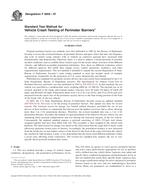Potřebujeme váš souhlas k využití jednotlivých dat, aby se vám mimo jiné mohly ukazovat informace týkající se vašich zájmů. Souhlas udělíte kliknutím na tlačítko „OK“.
ASTM F2656-07
Standard Test Method for Vehicle Crash Testing of Perimeter Barriers
Automaticky přeložený název:
Standardní zkušební metoda pro vozidla Crash testování obvodových bariér
NORMA vydána dne 1.8.2007
Informace o normě:
Označení normy: ASTM F2656-07
Poznámka: NEPLATNÁ
Datum vydání normy: 1.8.2007
Kód zboží: NS-54323
Počet stran: 16
Přibližná hmotnost: 48 g (0.11 liber)
Země: Americká technická norma
Kategorie: Technické normy ASTM
Anotace textu normy ASTM F2656-07 :
Keywords:
anti-ram barriers, anti-terrorist barriers, berms, bollards, continuous barriers, ditches, fixed barriers, fixed-width barriers, freestanding barriers, net barriers, operable barriers, perimeter barriers, perimeter gates, planter barriers, plate barriers, portable barriers, removable barriers, retractable barriers, security barriers, surface-mounted barriers, vehicle crash test, wedge barriers, ICS Number Code 43.180 (Diagnostic, maintenance and test equipment)
Doplňující informace
| Significance and Use | ||||||||||
|
This test method provides a structured procedure to establish a penetration rating for perimeter barriers subjected to a vehicle impact. Knowing the penetration rating provides the ability to select an appropriate barrier for site-specific conditions around a facility. The barrier penetration rating does not imply that a barrier will perform as rated in all site conditions, approach routes, and topography. Also, only single-specimen tests at a specified impact location are required by this test method, and therefore, not all points of impact can be tested and validated for the penetration rating. Other impact locations may respond differently. |
||||||||||
| 1. Scope | ||||||||||
|
1.1 This test method provides a range of vehicle impact conditions, designations, and penetration performance levels. This will allow an agency to select passive perimeter barriers and active entry point barriers appropriate for use at facilities with a defined moving vehicle threat. Agencies may adopt and specify those condition designations and performance levels in this test method that satisfy their specific needs. Agencies may also assign certification ratings for active and passive perimeter barriers based on the tests and test methodologies described herein. Many test parameters are standardized to arrive at a common vehicle type and mass, enhance test realism and replication, and produce uniform rating designations. 1.2 Compliance with these test procedures establishes a measure of performance but does not render any perimeter barrier invulnerable to vehicle penetration. Caution should be exercised in interpreting test findings and in extrapolating results to other than test conditions. While computer simulations are powerful tools that are useful in the development of new and improved barriers or in estimating performance under differing conditions, use of only the results from computer simulation for fielding a product is strongly discouraged. When performing a test, developers and users are encouraged to address specific or unusual site conditions as needed. Often local terrain features, soil conditions, climate, or other items will dictate special needs at specific locations. Therefore, if site conditions are likely to degrade a barriers performance, the agency in need of a perimeter barrier should require testing with the specific site conditions replicated for full-scale crash testing. 1.3 Product/design certification under this test method only addresses the ability of the barrier to withstand the impact of the test vehicle. It does not represent an endorsement of the product/design or address its operational suitability. 1.4 The values in SI units are to be regarded as the standard. The values shown in parentheses are for information only. This standard does not purport to address all of the safety concerns, if any, associated with its use. It is the responsibility of the user of this standard to establish appropriate safety and health practices and to determine the applicability of regulatory limitations prior to use. |
||||||||||
| 2. Referenced Documents | ||||||||||
|
Doporučujeme:
Aktualizace technických norem
Chcete mít jistotu, že používáte pouze platné technické normy?
Nabízíme Vám řešení, které Vám zajistí měsíční přehled o aktuálnosti norem, které používáte.
Chcete vědět více informací? Podívejte se na tuto stránku.




 Cookies
Cookies
